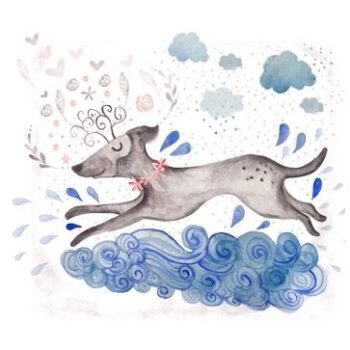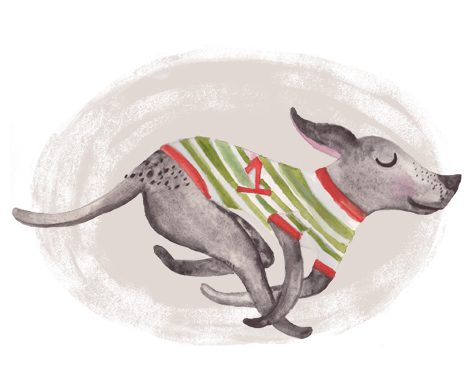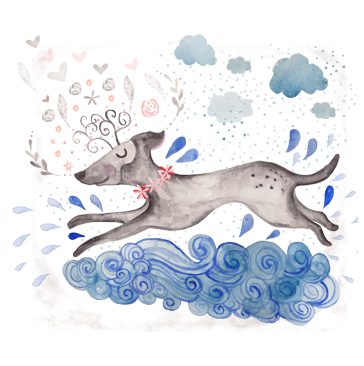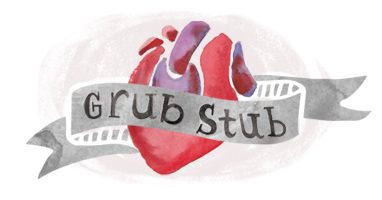
Stephanie Anderson’s “Greyhound” was selected by Emily Rapp as the winner of the second annual Payton Prize, which seeks to honor one excellent nonfiction essay each year in memory of Payton James Freeman, taken by SMA. This year’s theme was “The Stupid Little Thing That Saved Me.” Of the winning essay she chose, Emily writes:
“Greyhound” is a beautiful, haunting essay about the different kinds of love, and what we do to keep and hold those we love, even if they hurt us. Ultimately, it’s a story about a complicated survival and a willingness to carry on, to learn, to continue to be curious and loving, even when people disappoint you, often wildly. I was impressed by the amount of material this essay was able to hold: it was so compact, and yet it moved out in so many unexpected directions, and the author’s ability to juxtapose terror and tenderness without a hint of sentimentality, or without becoming overwrought, was impressive.
***
I live with a seventy-pound deer. That’s how people describe my greyhound, Dakota, as she sprints down the beach after a tossed coconut, just where the waves dissolve white into the sand. Sometimes she leaps over incoming surf like a fawn over a barbed wire fence. Watching her brings to mind other delicate-bodied animals: she has the thin legs of a foal, the hinged spine of a cheetah, the red-tan coat of a gazelle. The sleeping habits of a newborn kitten. Yet she can run forty miles per hour, far faster than any other dog breed. Her heart is more powerful than that of a Thoroughbred horse; it beats five times per second during a race. Because of her double-suspension gallop, her feet touch the ground just twenty-five percent of the time when running. She can see clearly for half a mile, a skill she uses these days for spotting possums ambling through the front yard at dawn.
Dakota raced for a year and eight months at an aging dog track in Hallandale Beach, Florida. I know this because of an identification number tattooed inside her left ear, which I can type into a greyhound racing website and see videos of every race she ran under her given name, Grub Stubs, one-hundred-and-four in all. Of these I have only watched a handful, and I admit they are the ones in which she wins because I can’t bear to see her fall or slammed into a guardrail. In one race, she bides her time in the back of the pack, gaining in the last half, then summoning a hidden strength and surging ahead to overtake a much larger white dog in the lead. In those thirty seconds, I can almost feel that massive heart beating, pumping her entire volume of blood through her body four to five times over.
I assume Dakota lived in one of the long, low-slung concrete kennels near the track, where cages likely lined each wall, stacked two high. I won’t pretend to know the horrors she experienced, but I can imagine based on news reports: dog paws sanded bloody in the night by rival trainers, twenty hours a day in a cage just big enough to stand up in, injections of steroids and cocaine, starvation, bones broken on the track left untended. At the end a greyhound’s career (if he or she survives), there’s a bullet, and that’s if the dog is lucky. Some are starved instead, others used for medical experiments. One poor girl—maybe she had the same red-tan coat of my greyhound—had a metal wire shoved into her rectum and an alligator clip attached to her lip. Someone stood her on a wet floor and electrocuted her while a room full of drunken racetrack employees looked on.
My greyhound was given to an adoption agency. On what grounds I don’t know, although I’m sure it helped that she was young and relatively uninjured (she bears scars but no missing legs, feet, or ears). I also suspect it had a lot to do with her flaws: she was likely deemed unfit for breeding due to her not-so-winning record and small stature (sometimes people mistake her for a whippet, she’s so short). Maybe these flaws saved her. The perfect greyhound is either raced to death, literally, or retired and bred to exhaustion. It’s unprofitable to race the imperfect greyhound for long, and if this greyhound can escape being executed for her inadequacies, then she might be rewarded for them.
 My first encounter with a greyhound was in a craft beer bar in Sioux Falls, South Dakota, in 2008. I was a college senior, an English major with a cliché stack of books under her arm and a tendency to write sad little poems in a black book after too much whiskey. Some drink special had lured me, my boyfriend, and some equally broke friends to the bar. I was sitting on a couch with a dark ale in my hand, probably in my brown suede coat with the fur ruff because it was January, and suddenly I turned and found a dog standing eye-level with me. I remember him like I remember seeing the ocean for the first time, an unforgettable image connected to a feeling of awe: a blue-gray coat, brown eyes looking into mine, a long and slender nose, tall as a pony but with the dainty look of a filly.
My first encounter with a greyhound was in a craft beer bar in Sioux Falls, South Dakota, in 2008. I was a college senior, an English major with a cliché stack of books under her arm and a tendency to write sad little poems in a black book after too much whiskey. Some drink special had lured me, my boyfriend, and some equally broke friends to the bar. I was sitting on a couch with a dark ale in my hand, probably in my brown suede coat with the fur ruff because it was January, and suddenly I turned and found a dog standing eye-level with me. I remember him like I remember seeing the ocean for the first time, an unforgettable image connected to a feeling of awe: a blue-gray coat, brown eyes looking into mine, a long and slender nose, tall as a pony but with the dainty look of a filly.
I don’t remember the bartender, who had stepped over to see if we needed another round. All I remember is the greyhound, who stood still as a photograph while I stroked his head. He asked for no affection with licks or tail wags—my friends called him aloof—but in order to stay near his owner he tolerated my petting, indifferent as the sea but just as majestic. I felt drawn to that dog like I had felt drawn into the Pacific two years earlier, my first time at the ocean, although neither the dog nor the water felt anything about my presence. Most of the time he didn’t look at me, but at his owner. When the woman walked away, the greyhound became her shadow. All night he was simply there, waiting for her to need him. Later she went outside for a cigarette and the dog stood at the glass door watching the snow swirl around her, his ears pricked, unmoving until she returned even though I called to him. Now I wonder what imperfection saved him. I like to imagine him as one of those hounds who refuses to race, who jumps out of the gate but sees through the fake rabbit pulled along the wire. He slows to a walk and looks back at his trainer as if to say, why bother?
That greyhound was loyalty, steadfastness, patience. He wanted only his owner’s love, and he took earning that love very seriously. There was no jumping, whining, or barking, but a quiet love burning like an ember. My future dog, I decided, would be like the one in the bar, and maybe he or she would be an actual greyhound, too. We would have an ember. I did not realize until years later that I unconsciously sought those traits in a marriage. And how funny it is that my future husband was sitting beside me that night, then the quietly adoring boyfriend who would someday adopt the little red greyhound with me.
*
I told a half-truth. I had seen greyhounds before the gentle giant in the bar. The thing is, I remember them only as a mass of bodies that terrified me, so I don’t count that as truly seeing or appreciating a greyhound.
I was seventeen and dating a criminal I’ll call John. I would discover his criminality a few months later, when he called from jail after attempting to pawn tools stolen from his road construction job. The tools were not the first things he had stolen. When we visited the greyhounds at his father’s farm, however, John was still, as I saw him, a Heath Ledger from 10 Things I Hate About You that I adored mostly because no one thought I should. John’s father was a construction worker, not a farmer, but the man had held on to an inheritance: a falling down barn, some corrals, and a few acres outside a small town in North Dakota, where he kept some horses and what I now realize was an unusual number of greyhounds.
I remember very little about seeing the dogs, which I’m sure is a result of my deliberate effort to erase John from my memory, an almost ten-year endeavor that has continued until right now, when I suddenly find myself needing one of those moments. I know a few things for sure: the hounds lived in the barn, and when they spotted us they stood on their hind legs with their front paws against the corrals, barking as if to keep the devil at bay. The barking stays with me, a sound like walking into a dog shelter but instead of a dozen dogs think thirty. That’s how many I would guess were in the barn. They were thin, although greyhounds are naturally slim. What I remember clearly is fear. Fear about getting too close to the fence, fear when I saw John’s dad walk through the pack with a bucket over his head—I thought the hounds would eat him instead of the food he was carrying—fear of discovering how so many greyhounds, a type of dog no one in these parts owned or knew anything about, had ended up on this remote farm.
There were things I knew not to ask John. Where did you disappear to for those two weeks, for example, or why do you not have bank accounts or how is it that you can buy me dinner and car accessories but never stay at one job for more than a month or two? Why do I get the feeling that the girl with her hair dyed so black it’s almost blue comes to your apartment ten minutes after I leave? And why three different apartments in a year? This question most of all: is this who you will always be? There were also questions I knew not to ask myself. What is the definition of shifty, and does it apply to John? Is a twenty-four-year-old guy without a high school degree really more mature than my classmates, who I thought I was better than? In those moments when you see that you are smarter than John, how your futures will split like a fork splits a road, why do you decide to stay?
Though I cannot say for sure, I doubt that North Dakota farm was a charitable home for retired racers. A fair review of John and his father from the distance of a decade confirms that they were not charitable people. Maybe John’s father had a dog-hoarding problem, like the women on TV who’ve collected a hundred cats. It may have been a puppy mill, although the dogs looked grown. Greyhounds typically stay on breeding farms until they are a year old, so I could have been looking at young hounds big enough to pass as adults to my uneducated eye. Or I might have been looking at dogs about to receive a bullet in their narrow skulls. Here’s why this is possible: in 2002, authorities discovered the remains of 3,000 greyhounds, all from Florida tracks, decaying on an Alabama property. For forty years, a former track guard had “retired” hounds with a .22 caliber rifle. Alabama can’t be the only place this happens, and the dog tracks in Winnipeg were just eight hours away. Whether that farm was an Auschwitz for greyhounds, I will never know. I was too afraid to ask for the truth.
*
Why don’t the greyhounds just refuse to run, some people ask. Because the hounds do not know what else to do. Their world is a circle track and a square cage. They do not know what love is, so they do not know to crave it. A few decline to race, like some Thoroughbreds do, but despite the starvation, the kennel prison, and the broken bones, most greyhounds run when asked, sometimes to the point of having a heart attack on the track. Their bodies tell them to run, but do not tell them when to stop.
and the broken bones, most greyhounds run when asked, sometimes to the point of having a heart attack on the track. Their bodies tell them to run, but do not tell them when to stop.
I see this trait in Dakota. If I don’t force her to rest, she will chase toys and dogs down the beach until she throws up. Her footpads turn red and sore from the sand, but she runs as if nothing is wrong. She often leaves limping, possibly because an old injury flares up. But I can’t deny my greyhound the beach. She howls at the phrase “dog beach” and spins circles when she sees me take out the beach bag, where I keep her prized bumper toy that floats in the water. She craves the uninhibited galloping like she craves her food at precisely six p.m.: her gut tells her she needs it.
*
For reasons I am still unsure about, I began letting go of John like an hourglass lets go of sand, steadily but slowly until nothing remained. I saw other people. I went to college and did not answer my phone for weeks. Then I stopped answering altogether and never spoke to him again, though we did not officially break up. We dissolved. I like to think that some part of me knew about the little red greyhound and the quietly burning ember of my future husband’s love. But that’s not true, because like racing greyhounds I did not know what love was. Letting go of John probably had more to do with the good influences in my life: family and friends who begged me to leave him, professors who revealed a world of literature and writing, even my ability to afford birth control. I feel for the girls who lack my watchful mother, my steadfast father, my home with food and clothes, the glimmer of a world beyond my immediate experience that I saw at just the right moment. Without these things, I might have been a girl who ended up with a John, who married him, had intended or unintended children with him, who bailed him from jail and cooked him Hamburger Helper for supper.
But there’s this: John and I did not dissolve because I decided we should. In actuality, I gave up. I was a greyhound who slowed to a trot, then walked off the track. My giving up involved more than good influences, because even girls with such influences choose Johns. Maybe my flaws saved me: my tendency to cheat when bored or angry, my ability to remove someone from my life like a surgeon cuts out a tumor, my Achilles-like pride that becomes wounded by betrayals that I, too, have committed, and my desire for self-preservation at the cost of loyalty. A perfect girl might have stayed, raced herself to death. I was not, and am still not, the perfect girl.
Like Dakota’s flaws likely spared her from a bullet, mine saved me from a bullet of sorts. By bullet I mean the life I would have had with John, one of pain, disappointment, wasted talents, little to no personal fulfillment. It’s not that women can’t stay with a John and find a version of happiness, or leave a John and make a new life, or that a John can’t change. A John is not a death sentence, but he is often an edge that young girls fall over, never to get up again. I see now that, like my red greyhound, I was rewarded for my flaws, that neither of us would have survived without them.
*
As I write this, my greyhound is laying upside down, an overturned antelope with four feet in the air, back legs spread like (I hate to say this) a girl in a Hustler magazine. No modesty, but why be modest when it’s just her and me this morning, listening to the barely there chirping of the brown lizards from the patio. We have an understanding, me and this seventy-pound deer. She lays on her dog bed; I sit on the couch. I write; she naps. Around noon she gets a treat and I eat lunch. We’ll go for hours without acknowledging each other, then go play Frisbee.
 I would rather have an ember than a quick-burning fire. The lesson of the grey greyhound from the bar, though I must have known it unconsciously beforehand because I already had an ember, my boyfriend. Now I have a hound that leaves a crowded room to follow me upstairs, and a boyfriend-turned-husband who will say aloud, unprompted and practically verbatim, thoughts I haven’t shared yet. I probably found the idea of an ember appealing (and still do) because that is how I see myself: loyal, steadfast, and patient, abstaining from jealousy, bitterness, and anger, possessing a quiet love whose heat never fluctuates or overcompensates.
I would rather have an ember than a quick-burning fire. The lesson of the grey greyhound from the bar, though I must have known it unconsciously beforehand because I already had an ember, my boyfriend. Now I have a hound that leaves a crowded room to follow me upstairs, and a boyfriend-turned-husband who will say aloud, unprompted and practically verbatim, thoughts I haven’t shared yet. I probably found the idea of an ember appealing (and still do) because that is how I see myself: loyal, steadfast, and patient, abstaining from jealousy, bitterness, and anger, possessing a quiet love whose heat never fluctuates or overcompensates.
Oh, if these characterizations were true. Instead I demand affection, question my husband’s happiness with me, and lash out at him when I’m stressed. My love may be long burning, but as a person I am hot and cold, some days over the top in my I-love-yous and others downright nasty with my words. I want to be an ember, but I fail, all the while expecting my husband to display the traits I cannot. Even my little red greyhound does a better job; she loves my husband like she loves me, watching from the upstairs window while he mulches the yard. If my marriage is a race around a long oval track, then I can only hope that I run like Dakota in her sprint against the white dog. I will bide my time in the back, gaining when I can, summoning hidden strength to overtake my flaws and be the partner with a massive, powerful heart, someone who deserves the bets placed on her.
Or perhaps my flaws have saved me yet again, because they are the perfect match for someone else’s flaws. Flaws could be like puzzle pieces, unique but ultimately made to fit other pieces. Maybe a marriage is simply a collection of flaws and good traits whose grooves fit together to build a beautiful whole. Maybe our flaws are the stupid little things that save us.
***
Rumpus original art by Rachael Schafer.






